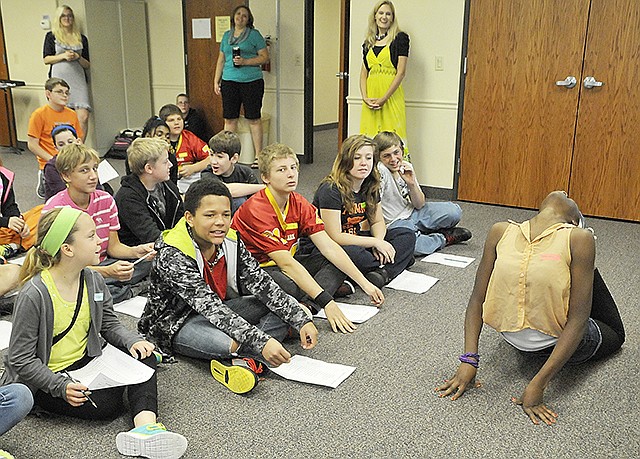Nearly 50 Lewis and Clark Middle School students on Thursday participated in a day-long program aimed at dissuading them from experimenting with alcohol and tobacco, and arming them with the tools they'll need to halt bullying.
Facilitators from Jefferson City's Council for Drug Free Youth used interactive games, personality quizzes, straw polls, video clips and several other educational strategies to drive their message home to the seventh-grade crowd. The group is one of several that will be pulled out of class in the weeks to come to learn more about the topic.
Melle Richardson used a game-show style presentation to hammer home a few factoids about tobacco use.
"How many people die every day?" she intoned.
"4,000?" asked Gerrad Gunier.
"2,000?" guessed Karsten Byrd.
"It's 1,300," Richardson prompted.
After explaining to students her own struggle with quitting smoking, Richardson shared several facts about smoking. She noted nine out of 10 people start before they are 18. She added 18 percent of high school students choose to smoke. And she said cigarettes are filled with harmful chemicals that pollute the human body.
Richardson said kicking the addiction was the hardest thing she ever did.
"How many of you have parents who smoke? How many of you have parents who have quit?" she asked. "If they have quit, you should give them a big hug and keep encouraging them, because it's a very, very difficult thing to do."
The message on bullying seemed to resonate the most with the students. At lunch, several of the kids said they definitely felt it was a "big problem" for kids their age.
"It makes it harder to make friends," said Morgan Kirschner.
But she felt the day-long program held the capacity to make a difference.
"I think people will be more tolerant," she added. "If you are bullied, you should tell a teacher. Tell a friend. Or just speak up for yourself."
Kyra Sanders, 13, said that cyberbullying has taken a bad problem and made it worse. Kids pick on one another for how they dress or if their families can't afford the latest shoes or iPhone.
"Kids are now bullied with text messages, on Facebook, on Snapchat," she said. "It can happen at school or on the streets."
Sanders said someone once told her she was ugly.
"It really made me mad. But, you know? I'm beautiful. I'm not worried about it."
Sanders' friend, Daemonie Edwards, was more frank about her impression of the council's program. She wasn't convinced her peers were listening to the message.
Asked if she thought the program was beneficial, Edwards replied: "No. They just see it as a day out of school."
Tristan Shipp, 13, didn't share Edwards' conviction. He said Thursday's program was "good for people."
He said teens today generally don't experience old-school bullying like being shoved in a locker or having their lunch money stolen. But group bullying hasn't waned, he said.
"Some people are just the way they are, and there's not much changing that. They target people without friends ... single individuals," Shipp said. "It makes (the bullies) feel more powerful and causes their social status to go up within the group."
Bullying is not going to stop, he said. But other teens - because they experienced the council's anti-bullying message - may pause first before saying something hurtful.
"It's a good program overall," Shipp said.

